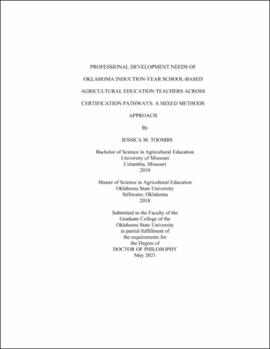| dc.contributor.advisor | Terry, Robert, Jr. | |
| dc.contributor.author | Toombs, Jessica M. | |
| dc.date.accessioned | 2021-09-23T19:42:44Z | |
| dc.date.available | 2021-09-23T19:42:44Z | |
| dc.date.issued | 2021-05 | |
| dc.identifier.uri | https://hdl.handle.net/11244/330840 | |
| dc.description.abstract | School-based agricultural education (SBAE), like many other subject areas, suffers from a critical teacher shortage. Oklahoma has chosen to combat this shortage by offering temporary emergency teaching certifications with minimal qualifications and no requirements for professional development. Recruitment is only half of the solution to teacher shortages. Retention is needed to stem the flow of novice teachers exiting the profession. Induction support through professional development is a necessary component to teacher retention. Although all SBAE induction-year teachers require support, how do the professional development needs differ across certification pathways? Previous research has approached this question with quantitative, self-report measures. However, one must ask whether these beginning professionals are knowledgeable enough about their abilities to report professional development needs. This study sought to answer those questions using mixed methodologies. Grounded in Bandura's (1997) theory of self-efficacy and using a convergent parallel model, preexisting instruments were used to gather Oklahoma induction-year SBAE teachers' (N = 29) sense of self-efficacy in the areas of instruction, FFA, and SAE. Items receiving a rating of low teacher self-efficacy were recorded as self-identified professional development needs. From this population, five case study participants were selected for the qualitative phase. Interview transcripts, observation notes, and artifacts were collected during two site visits to each case study participant. Emergency certified teachers returned more professional development needs from teaching observations but reported fewer areas of low teacher self-efficacy on quantitative instruments in comparison to their traditionally certified counterparts. The areas of professional development needs varied widely between individuals. Personal, environmental, and behavioral factors played a part in determining the professional development needs for each SBAE induction-year teacher. Therefore, it is recommended professional development be tailored to the individual induction-year teacher. Mentoring and online resource banks have the potential to provide the necessary individualized professional development support of SBAE induction-year teachers. | |
| dc.format | application/pdf | |
| dc.language | en_US | |
| dc.rights | Copyright is held by the author who has granted the Oklahoma State University Library the non-exclusive right to share this material in its institutional repository. Contact Digital Library Services at lib-dls@okstate.edu or 405-744-9161 for the permission policy on the use, reproduction or distribution of this material. | |
| dc.title | Professional development needs of Oklahoma induction-year school-based agricultural education teachers across certification pathways: A mixed methods approach | |
| dc.contributor.committeeMember | Ramsey, Jon W. | |
| dc.contributor.committeeMember | Robinson, J. Shane | |
| dc.contributor.committeeMember | Ivey, Toni A. | |
| osu.filename | Toombs_okstate_0664D_17078.pdf | |
| osu.accesstype | Open Access | |
| dc.type.genre | Dissertation | |
| dc.type.material | Text | |
| dc.subject.keywords | emergency teacher certification | |
| dc.subject.keywords | induction-year teachers | |
| dc.subject.keywords | mixed methods | |
| dc.subject.keywords | professional development | |
| dc.subject.keywords | school-based agricultural education | |
| dc.subject.keywords | traditional teacher certification | |
| thesis.degree.discipline | Agricultural Education | |
| thesis.degree.grantor | Oklahoma State University | |
